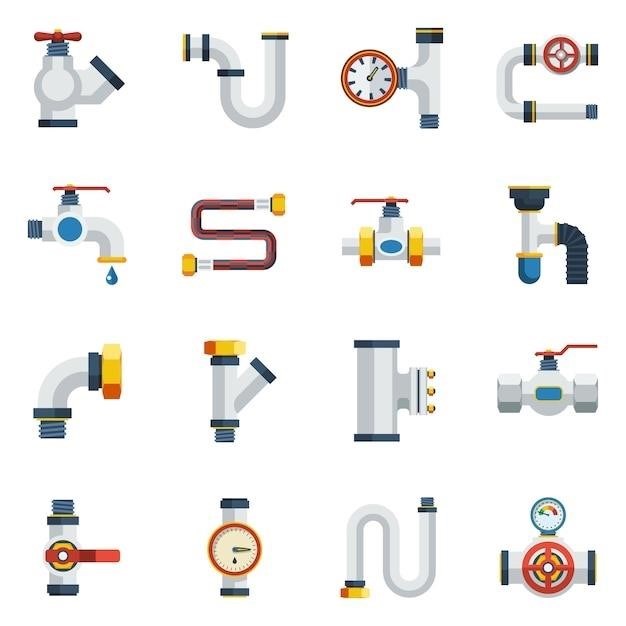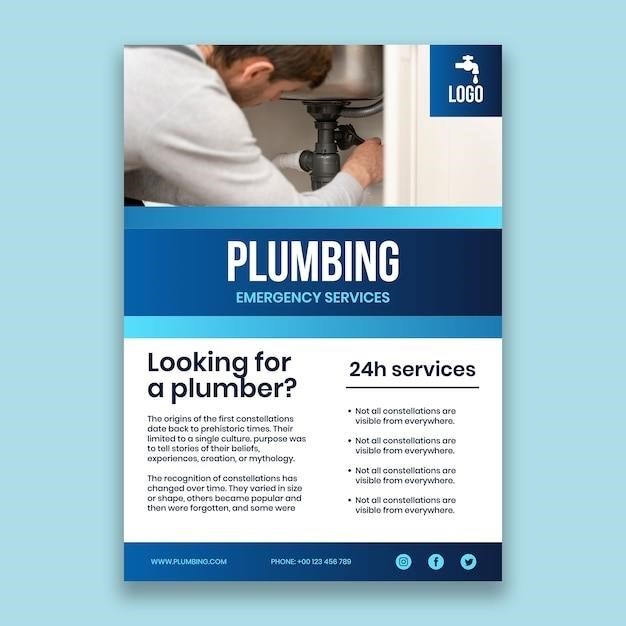Siphon Pump Manual⁚ A Comprehensive Guide
This comprehensive guide delves into the world of siphon pumps‚ exploring their various types‚ applications‚ and proper usage. We’ll cover everything from the basics of how they work to essential safety precautions and troubleshooting tips. Whether you’re a homeowner tackling a DIY project or a professional seeking reliable fluid transfer solutions‚ this manual will equip you with the knowledge you need to utilize siphon pumps effectively and safely.
Introduction
Siphon pumps are ingenious devices that harness the power of gravity and atmospheric pressure to transfer liquids from one container to another without the need for an external power source. Their simplicity and effectiveness make them indispensable tools for a wide range of applications‚ from draining aquariums and transferring fuel to moving liquids in industrial settings. A siphon pump operates on the principle of creating a pressure difference between the source and destination containers. This pressure difference is achieved by filling a tube with the liquid to be transferred and then creating a vacuum at the top of the tube. Once the vacuum is established‚ gravity pulls the liquid down the tube and into the destination container. The flow continues until the liquid levels in both containers are equalized.
Siphon pumps are a versatile and efficient solution for a variety of fluid transfer needs. Their ease of use‚ portability‚ and affordability make them a popular choice for both home and professional applications. This manual will provide a comprehensive overview of siphon pumps‚ covering their different types‚ working principles‚ applications‚ and safety precautions. Whether you’re a homeowner seeking to drain a flooded basement or a professional involved in fuel transfer operations‚ this guide will equip you with the knowledge and insights to utilize siphon pumps effectively and safely.
Types of Siphon Pumps
Siphon pumps come in a variety of designs‚ each tailored to specific applications and fluid types. Understanding the different types available will help you choose the most suitable pump for your needs.
Manual Siphon Pumps⁚ These pumps rely on manual operation to initiate and maintain the siphon action. They typically consist of a flexible tube‚ a hand pump‚ and a valve system. To start the siphon‚ the tube is filled with the liquid‚ and the hand pump is used to create a vacuum at the top of the tube. This initiates the flow‚ which continues until the liquid levels in both containers are equalized. Manual siphon pumps are ideal for occasional use and small-scale fluid transfers‚ as they are portable‚ affordable‚ and require no external power source.
Electric Siphon Pumps⁚ These pumps utilize an electric motor to power a pump that draws the liquid from the source container and pushes it into the destination container. Electric siphon pumps offer higher flow rates and are well-suited for larger volumes and more demanding applications. They are often used for transferring fuels‚ oils‚ and other liquids in industrial and commercial settings.
Other Types⁚ Beyond these basic categories‚ there are various specialized siphon pumps designed for specific purposes. For example‚ some pumps are specifically designed for transferring delicate liquids or for use in sensitive environments. Choosing the right type of siphon pump is crucial for ensuring safe and efficient fluid transfer.
Manual Siphon Pumps
Manual siphon pumps are the simplest and most common type of siphon pump. They are often used for everyday tasks such as transferring fuel‚ draining water from a fish tank‚ or emptying a container. Manual siphon pumps work by using a hand pump to create a vacuum at the top of the tube‚ which then draws the liquid up and over the edge of the container.
Manual siphon pumps are typically made from durable materials like plastic or metal‚ making them resistant to corrosion and wear. They are also relatively inexpensive and easy to use‚ making them a popular choice for both home and professional applications. However‚ manual siphon pumps have a lower flow rate than electric pumps and are not suitable for large-scale applications.
Here are some common features of manual siphon pumps⁚
- Hand pump⁚ Used to create the vacuum that initiates the siphon flow.
- Flexible tube⁚ Allows the pump to be used with various container sizes and shapes.
- Valve system⁚ Controls the flow of liquid and prevents backflow.
- Check valve⁚ Prevents the liquid from flowing back into the source container.
- Dipstick tube⁚ Used to measure the level of liquid in the source container.
- Air pressure hose⁚ Used to inflate small objects.
Manual siphon pumps are a versatile and convenient tool for various fluid transfer tasks.
Electric Siphon Pumps
Electric siphon pumps offer a more powerful and efficient solution for fluid transfer compared to their manual counterparts. These pumps utilize an electric motor to generate the suction force required to move liquids‚ eliminating the need for manual pumping. Electric siphon pumps are particularly advantageous for large-volume transfers‚ heavy-duty applications‚ and situations where continuous flow is desired.
Electric siphon pumps are commonly employed in diverse settings‚ including⁚
- Industrial Applications⁚ Transferring large quantities of liquids in manufacturing processes.
- Agricultural Applications⁚ Pumping water for irrigation or transferring fuel for farm equipment.
- Construction Applications⁚ Removing water from construction sites or transferring fluids in concrete mixing.
- Marine Applications⁚ Transferring fuel or bilge water in boats.
Electric siphon pumps are available in various sizes and configurations‚ with different flow rates and power outputs to suit specific needs. Features that often characterize electric siphon pumps include⁚
- Electric motor⁚ Provides the power to drive the pump.
- Switch⁚ Controls the pump’s operation.
- Hose connections⁚ Allows for easy attachment of hoses to the pump.
- Filter⁚ Prevents debris from entering the pump.
- Adjustable flow rate⁚ Allows users to control the rate of liquid transfer.
Electric siphon pumps offer increased efficiency and convenience for fluid transfer tasks‚ making them a valuable tool for a wide range of applications.

Choosing the Right Siphon Pump
Selecting the right siphon pump for your specific needs is crucial for ensuring efficient and safe fluid transfer; Consider these factors when making your decision⁚
- Type of Liquid⁚ The liquid you plan to transfer will influence the pump’s material compatibility. For example‚ pumps intended for fuel transfer will be constructed with materials resistant to gasoline and other petroleum products.
- Flow Rate⁚ The volume of liquid you need to transfer will determine the required flow rate of the pump. Higher flow rates are needed for large-volume transfers.
- Lift Height⁚ The vertical distance between the source container and the destination container is known as the lift height. The pump must be capable of overcoming this height difference.
- Pump Power⁚ Manual pumps are suitable for smaller-scale applications‚ while electric pumps offer more power for larger volumes and higher lift heights.
- Hose Length⁚ Ensure the pump’s hose is long enough to reach the source and destination containers.
- Ease of Use⁚ Consider the pump’s design and features‚ such as ease of assembly‚ operation‚ and cleaning.
Additionally‚ it’s essential to consider the specific application and potential hazards. Some applications may require pumps with additional features like a safety valve or a filter to prevent debris from entering the pump.
By carefully considering these factors‚ you can choose a siphon pump that meets your specific requirements and ensures safe and efficient fluid transfer.
Using a Siphon Pump
Using a siphon pump is relatively straightforward‚ but following these steps ensures safe and efficient operation⁚
- Prepare the Containers⁚ Ensure the source container is positioned higher than the destination container. The difference in height creates the necessary pressure gradient for siphoning.
- Connect the Tubes⁚ Connect the intake tube to the source container and the discharge tube to the destination container. Secure the tubes to prevent leaks.
- Prime the Pump⁚ For manual pumps‚ squeeze the bulb or pump handle to create suction and draw liquid into the intake tube. Electric pumps may have a priming mechanism or require a separate manual priming step.
- Start the Siphon⁚ Once the intake tube is filled with liquid‚ the siphon will start flowing. The liquid will flow continuously as long as the pressure gradient is maintained.
- Monitor the Flow⁚ Observe the flow rate and ensure the liquid is transferring smoothly. If the flow slows or stops‚ check for any obstructions or leaks in the tubes.
- Stop the Siphon⁚ To stop the siphon‚ simply lift the intake tube out of the source container or pinch the discharge tube to interrupt the flow. Allow the liquid to drain completely from the tubes before disconnecting them.
For larger-volume transfers‚ consider using a siphon pump with a flow rate that matches your needs. If you’re transferring flammable liquids‚ be sure to use a pump designed for flammable liquids and follow all safety precautions.
Remember to always refer to the manufacturer’s instructions for specific guidance on your pump model.
Safety Precautions
Siphon pumps are generally safe to use‚ but certain precautions are essential to prevent accidents and ensure proper handling; Here’s a comprehensive list of safety guidelines to keep in mind⁚
- Avoid Flammable Liquids⁚ Exercise extreme caution when using siphon pumps to transfer flammable liquids like gasoline‚ kerosene‚ or alcohol. Always work in a well-ventilated area‚ away from any open flames or heat sources. Static electricity can ignite flammable vapors‚ so grounding the containers and the pump is recommended.
- Protective Gear⁚ Wear appropriate personal protective equipment (PPE) when handling any liquid‚ including gloves‚ eye protection‚ and a face mask. This protects you from potential splashes and harmful fumes.
- Careful Handling⁚ Handle siphon pumps with care‚ as they can be fragile. Avoid dropping or mishandling the pump‚ as this can damage the tubes or the pump itself.
- Cleanliness⁚ Clean the siphon pump thoroughly after each use‚ especially if you’ve transferred corrosive or toxic liquids. This prevents cross-contamination and ensures future use.
- Storage⁚ Store siphon pumps in a dry‚ cool place‚ away from direct sunlight and excessive heat. Avoid storing them near corrosive substances or chemicals.
- Proper Disposal⁚ Dispose of any leftover liquid according to local regulations. Never pour flammable liquids down drains or into the environment.
If you’re unsure about any aspect of safety‚ consult the manufacturer’s instructions or a safety professional.
Maintenance and Cleaning
Regular maintenance and cleaning are crucial for extending the lifespan of your siphon pump and ensuring its optimal performance. Here’s a step-by-step guide on how to keep your siphon pump in top condition⁚
- Disassemble⁚ After each use‚ carefully disassemble the siphon pump. This includes separating the tubes‚ the pump body‚ and any other components.
- Rinse⁚ Rinse all parts of the pump with clean water. If you’ve transferred corrosive or toxic liquids‚ use a mild detergent solution to remove any residue.
- Inspect⁚ Inspect the tubes for any cracks‚ holes‚ or signs of wear. Replace any damaged tubes immediately.
- Clean the Bulb⁚ For pumps with a squeeze bulb‚ remove the bulb and clean it thoroughly with water. Ensure all internal passages are free of debris.
- Dry⁚ Thoroughly dry all parts of the pump before reassembly. You can air dry them or use a clean cloth to wipe them dry.
- Reassemble⁚ Carefully reassemble the siphon pump‚ ensuring that all parts are properly connected.
- Storage⁚ Store the cleaned and dried siphon pump in a safe place‚ away from direct sunlight and heat.
By following these simple maintenance and cleaning procedures‚ you can ensure that your siphon pump remains functional and reliable for years to come.
Applications of Siphon Pumps
Siphon pumps are versatile tools with a wide range of applications‚ making them indispensable for various tasks around the home‚ garage‚ and even in professional settings; Their ability to transfer liquids without the need for external power makes them ideal for a variety of situations. Here are some common applications of siphon pumps⁚
- Fluid Transfer⁚ Siphon pumps excel at transferring liquids from one container to another‚ whether it’s gasoline from a car to a jerrycan‚ water from a fish tank for cleaning‚ or kerosene from a heater to a storage container.
- Automotive Maintenance⁚ They’re essential for tasks like changing engine oil‚ draining coolant‚ and transferring fuel.
- Aquarium Maintenance⁚ Siphon pumps are used to remove debris and waste from the bottom of aquariums‚ making water changes easier and cleaner.
- Home Improvement⁚ They can be used to drain water from flooded basements‚ remove water from clogged sinks or tubs‚ and transfer water from a rain barrel to watering cans.
- Gardening⁚ Siphon pumps are useful for transferring water from a pond or barrel to water plants‚ making it easier to irrigate gardens without heavy lifting.
- Industrial Applications⁚ Siphon pumps are used in a variety of industrial applications‚ such as transferring chemicals‚ filling containers‚ and draining tanks.
Their simplicity‚ efficiency‚ and affordability make siphon pumps a valuable tool for a wide range of tasks.
Troubleshooting Siphon Pumps
While siphon pumps are generally reliable‚ occasional issues can arise. Understanding common problems and how to address them can ensure smooth operation. Here’s a guide to troubleshooting siphon pumps⁚
- No Flow⁚ The most common issue is a lack of flow. This could be due to a blockage in the tubing‚ a leak in the siphon‚ or a faulty pump mechanism. First‚ inspect the tubing for any kinks or obstructions. If you find none‚ check the pump for any loose parts or cracks. A leak in the pump or tubing will prevent the siphon from working.
- Intermittent Flow⁚ If the flow starts and stops‚ the siphon might be losing prime. This often occurs when the tubing is not properly secured or the pump is not submerged deep enough in the source container. Ensure the tubing is fully submerged and securely attached to the pump.
- Slow Flow⁚ A slow flow can be caused by a clogged pump or a kink in the tubing. Inspect the pump for any blockages and straighten any kinks in the tubing.
- Spills⁚ Spills can occur if the siphon is not properly positioned or if the tubing is not securely attached. Double-check the positioning of the siphon and make sure the tubing is tightly connected.
- Faulty Pump⁚ If the pump is damaged or worn out‚ it may not be able to create enough suction to start the siphon. Check the pump for any cracks‚ leaks‚ or loose parts. If the pump is damaged‚ it will need to be replaced.
By addressing these common issues‚ you can keep your siphon pump operating efficiently and ensure smooth fluid transfer for your projects.
Siphon pumps offer a simple and efficient solution for transferring liquids‚ making them valuable tools for a variety of applications. From home improvement projects to automotive maintenance‚ these pumps provide a convenient way to move fluids without the need for electricity or complex machinery.
By understanding the different types of siphon pumps‚ choosing the right one for your needs‚ and adhering to safety precautions‚ you can effectively and safely utilize these versatile tools. Regular maintenance and cleaning will ensure optimal performance and longevity‚ while troubleshooting tips can help address any issues that may arise.
Whether you’re transferring fuel‚ draining a fish tank‚ or tackling a plumbing project‚ siphon pumps offer a reliable and convenient method for moving liquids with minimal effort. By following the guidelines presented in this manual‚ you can confidently utilize siphon pumps for a wide range of tasks‚ ensuring smooth and successful fluid transfer every time.



Leave a Reply
You must be logged in to post a comment.